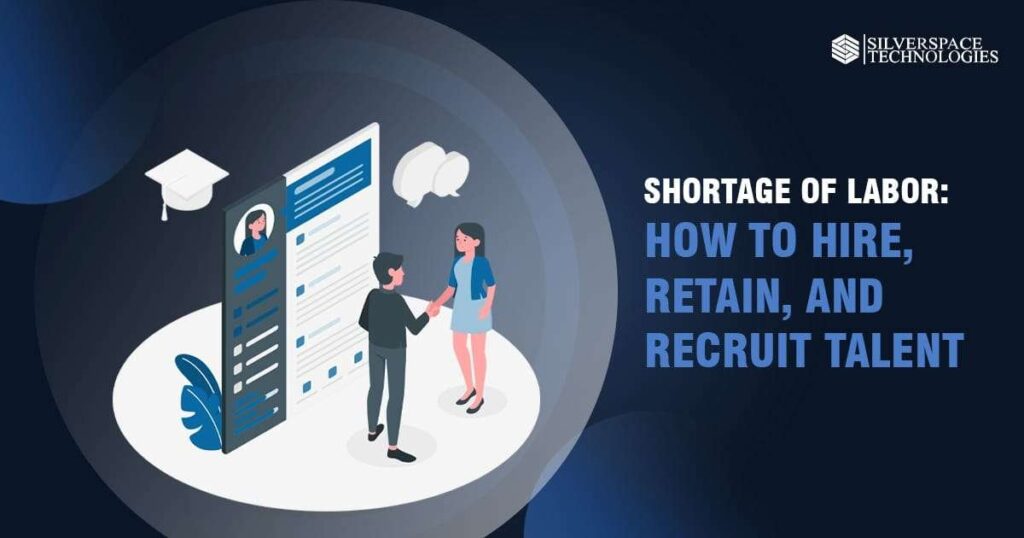How to Attract, Hire, and Keep Talent When There Is a Shortage of Workforce.
Restrictions are being loosened as the United States recovers from the pandemic, and market demand for products and services is surging. Employers are battling to secure their open positions in order to meet this demand, with the Bureau of Labor Statistics reporting a near-record number of job postings (BLS). Even if there are many available positions, unemployment is still high. Although it may seem contradictory, the United States is also experiencing a significant labor shortage, making it more difficult than ever for employers to locate qualified employees. The U.S. Chamber of Commerce reported that there was a record 8.1 million job opportunities in the country on May 31st, but a disproportionately small number of workers were available to fill them. This reinforced the shortfall. The months following recent or prior U.S. economic downturns, which recovered with an employer-driven economy and robust competition for jobs, are fundamentally different from the current situation of high unemployment coupled with a shortfall of available, skilled employees. Experts identify a number of potential drivers of these disparities, such as corporate restructuring, in which some jobs are lost and others are added, a stronger emphasis on increasing compensation for hourly and lower-paid roles, and regional moves for non-work-related reasons during the epidemic. Seeking, Hiring, and Managing Talent During a Skills Gap. Numerous economists and business executives have offered solutions and advice in response to the recruiting issue to deal with the rising number of unfilled positions and the general labor shortage. Provide competitive pay, particularly for hourly and lower-paid positions. Although it may be obvious, money is still frequently cited by job searchers as the most important consideration when deciding whether or not to accept a position. Despite this, pay levels have essentially stayed unchanged for years in many industries. Employers must provide competitive pay in order to attract, retain, and hire people in the competitive labor market. To attract more people, some businesses are getting inventive with incentives, giving signing bonuses and even schemes to pay off student loan debt. Review your benefits package again and, if required, make modifications. It is now more crucial than ever to provide employees with a full benefits package. This goes above and beyond the usual benefits packages that are typically provided by employers, such as health insurance, paid time off, and a 401(k). An employee benefits expert claimed in a Forbes article that many businesses offer their employees optional perks like pet insurance, financial assistance, and other things. These can frequently be provided at no expense to the company while giving staff members the option to enroll in a more complete or comprehensive program that better suits their needs. Reevaluate what being an employee implies. Employers can boost the appeal of their positions by offering more flexibility in addition to better pay and perks. This can entail adopting a 4/10 workweek structure or allowing for flexible work hours. When needed office hours are changed to be outside of regular rush hours, and commute times are drastically cut, which results in improved employee satisfaction and perhaps a wider/deeper candidate pool. Maintaining remote work should be a priority for businesses and jobs that permit it. A recent study found that 58% of employees who worked remotely during the epidemic indicated they would “definitely” seek out a new position if their recruiter did not permit them to do so. There is evidence that employees value the ability to work remotely, with the average employee valuing remote work at about 8% of their salary. Organizations should make sure that COVID-related safety and wellness programs are current for in-office settings and that staff feel secure and at ease when they return to work. On the website of the Centers for Disease Control and Prevention, you may get the most recent advice and suggestions for safe business practices. Review your employment requirements and job descriptions. Consider changing the minimal qualifications for your available roles if your job requirements are too precise and you’re not getting the type of candidate flow you need. Eliminating highly specialized business, software, or industry experience could solve this problem quickly and easily. The May U.S. Chamber of Commerce study highlighted these suggestions, urging firms to remove obstacles that keep people from entering the workforce. One step in doing this is reducing prerequisites and offering training to help job seekers acquire the necessary skills and experience. If you’re having trouble filling positions due to the labor crisis or want to review your recruiting tactics, think about working with a recruitment and employment expert. A large pool of available, skilled applicants is available at Silverspace Technologies, one of the best staffing and hiring firms in the United States. We place remote individuals in a variety of specialties, including information technology, office/administrative, accounting and finance, and creative. We can help you with Recruitment & Interview Process
How to Attract, Hire, and Keep Talent When There Is a Shortage of Workforce. Read Post »
